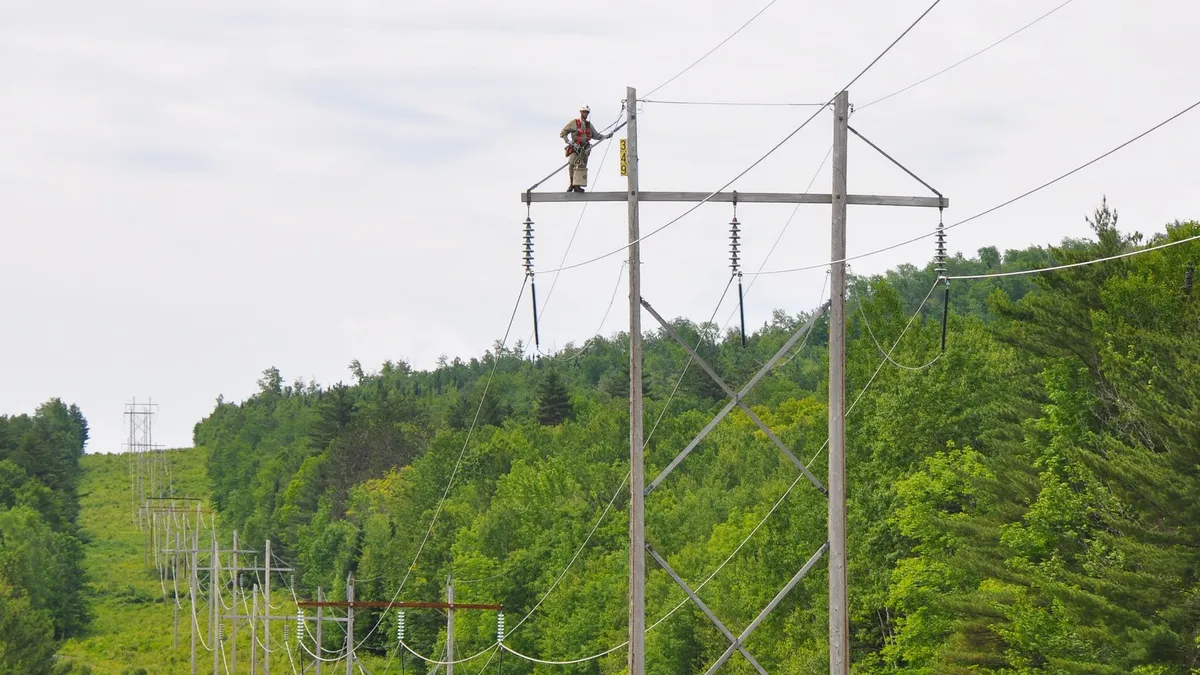Dive Brief:
- New England transmission owners are making it impossible to assess the prudence of certain transmission projects they put into service in 2022, the Maine Office of Public Advocate told federal regulators Wednesday.
- The “asset condition” projects — rebuilding and replacing aging lines and facilities — receive virtually no review for their reasonableness by states or ISO New England, according to a filing at the Federal Energy Regulatory Commission by Maine’s ratepayer advocate.
- “Maine's concern is that at least some New England utilities may be taking advantage of this lax review process to the benefit of their shareholders,” William Harwood, Maine’s public advocate, and Andrew Landry, a deputy public advocate, said in the challenge to a July 31 annual formula rate filing at FERC by the transmission owners.
Dive Insight:
The dispute over the asset condition projects comes amid concerns across the United States that relatively low-level transmission projects needed to replace old equipment and maintain local grid reliability receive little regulatory scrutiny.
In New England, ratepayer advocates and the Massachusetts attorney general in September asked the region’s utilities to stop new asset condition projects until the review process for them is revised. The New England States Committee on Electricity, which represents the region’s governors, has also been pressing for reforms to the process.
And in Ohio, utilities have added nearly $6.5 billion in PJM Interconnection-approved “supplemental projects” since 2017 without oversight of their need, prudence and cost-effectiveness, the Ohio ratepayer advocate said in a complaint filed at FERC in September.
Critics of FERC’s formula rate process, including FERC Commissioner Mark Christie, contend it makes it harder to determine whether transmission spending is prudent.
New England utilities are proposing a 9% hike in transmission rates for next year, with similar increases expected over the following four years, partly driven by asset condition projects, according to the Maine ratepayer advocate. The region’s transmission rates are the highest in the United States compared to other regions, Landry said in an interview.
The transmission owners estimate that last year they spent $1.35 billion on “regional network system” transmission projects, including $571 million, or 42% of the total, on asset condition projects, and expect to spend $1.39 billion this year, including $889 million, or 64% of the total, on asset condition projects, according to a rate forecast overview.
In violation of ISO-NE rules, the transmission owners have refused to answer questions from the ratepayer advocate’s office about their investment policies and practices related to the prudence of the asset condition projects, according to the filing.
The utilities contend the information requests fall outside the scope of New England’s formula rate process, according to the ratepayer office. Also, they argue the office failed to raise “serious doubt” about the prudence of their spending, which they say is a prerequisite for asking the questions, the ratepayer advocates said.
Utilities with asset condition projects that are the focus of the ratepayer advocate’s challenge are Avangrid’s Connecticut Light and Power Co., Maine Electric Power Co., two Eversource Energy utilities — NSTAR Electric Co. and Public Service Co. of New Hampshire — National Grid’s New England Power Co., PPL’s Rhode Island Energy and Vermont Transco.
The ratepayer advocate’s office has various questions about the asset condition projects, including whether utilities are building them prematurely and whether they could be more targeted and smaller, according to the filing.
“Are there less expensive alternatives to large transmission replacement projects?” Harwood and Landry asked. “Do [the utilities] have processes for maximizing the timing of replacements or the evaluation of non-transmission or hybrid alternatives?”
The transmission owners have committed to increasing the amount of information they provide about asset condition projects and expanding opportunities for stakeholder feedback, according to a Jan. 29 letter they sent to the Consumer Advocates of New England included with the Maine filing.
While a positive step, those commitments don’t address Maine's concerns about the transmission owners' current investment planning practices and whether the costs of the current asset management projects were prudently incurred, the ratepayer advocate’s office said.
The lack of scrutiny of asset condition projects may make it harder to ensure they are “right-sized” for future transmission needs in the area, Landry said. ISO-NE is considering options for ensuring that asset condition projects consider potential future transmission needs, he said.
“If [utilities are] just doing replacement projects, they may be missing opportunities to upgrade facilities to address those future needs,” Landry said. “And if they're doing it just because they won't have any regulatory review, that's a concern.”
The ratepayer office asked FERC to direct the transmission owners to answer Maine's questions and to let the state challenge the prudence of the asset management costs reflected in the July informational filing after answers to the questions have been provided.














